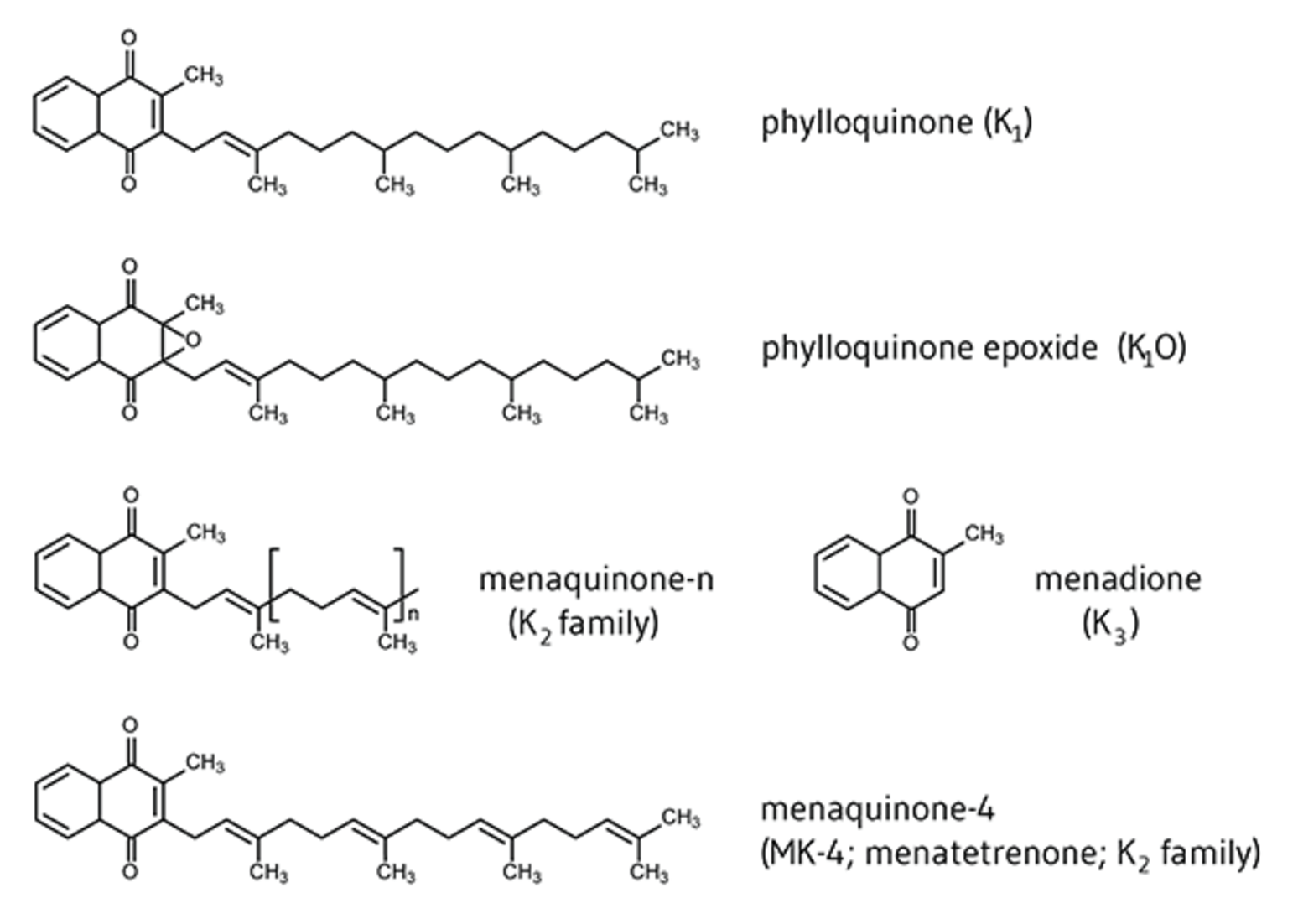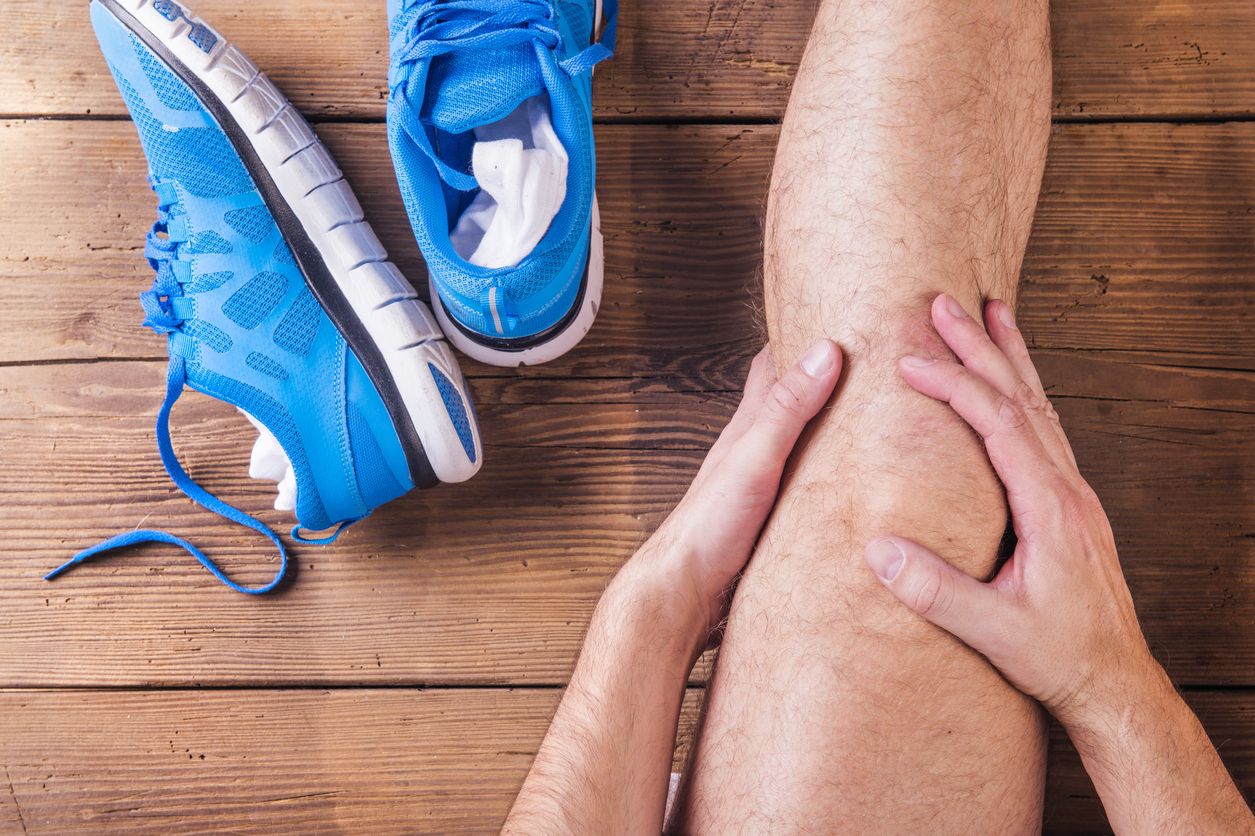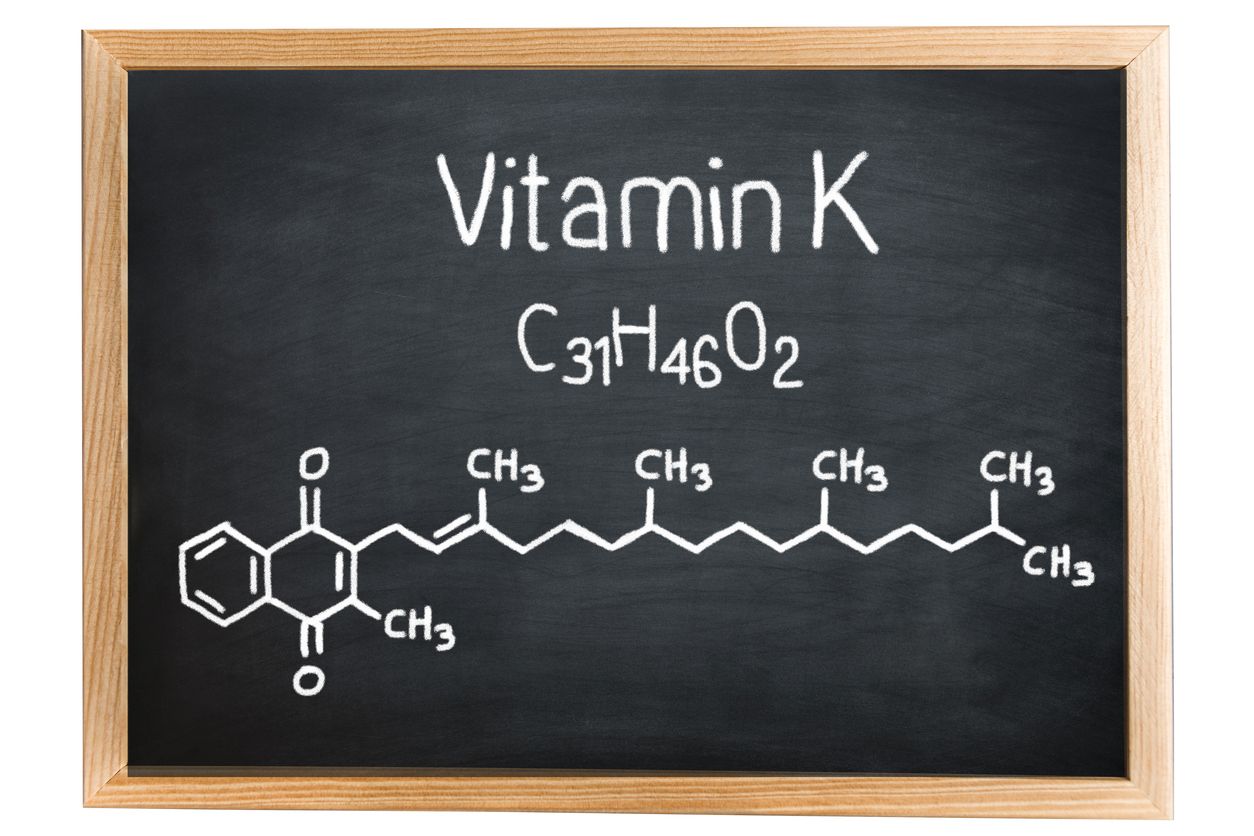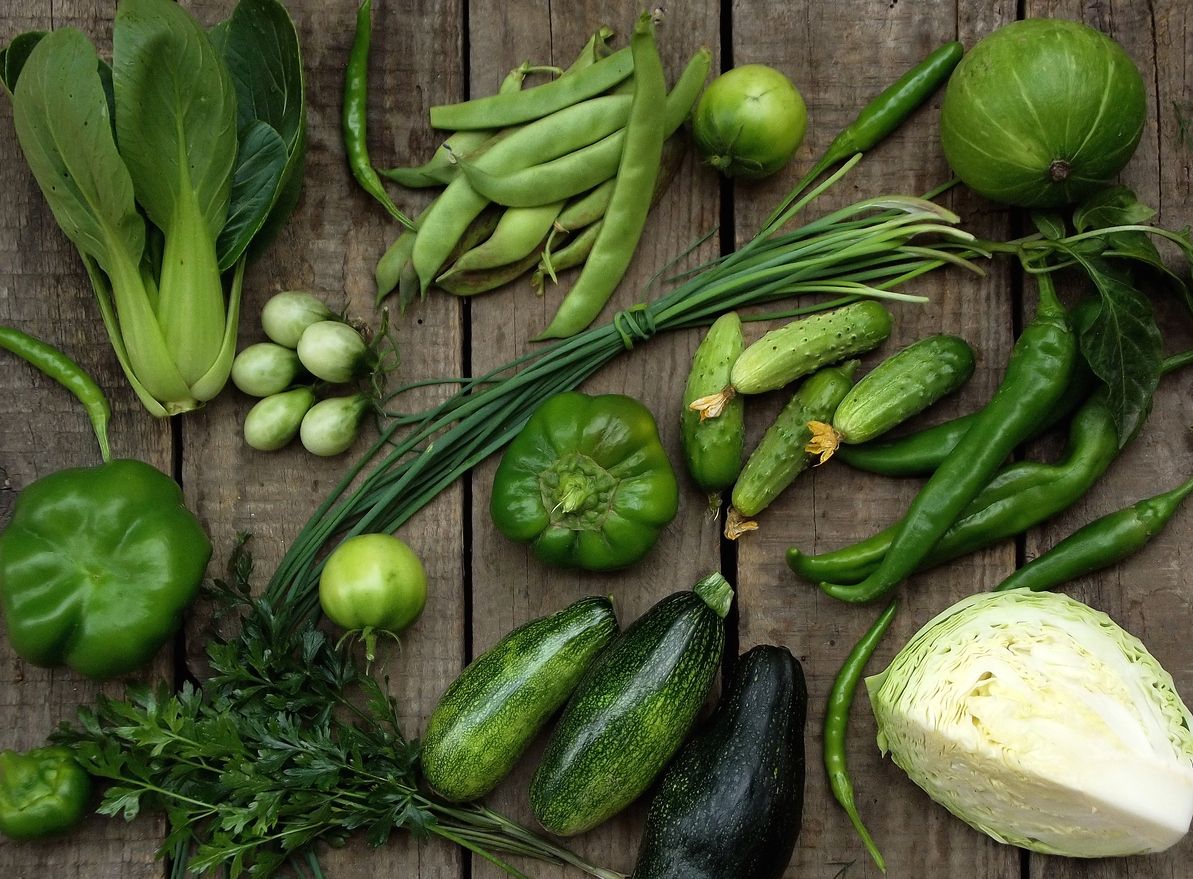Table of Contents
It helps prevent osteoporosis, fractures and reduces the risk of inflammation. In addition, vitamin K2 also improves bone health in postmenopausal women. Find out which foods you find it and why it is usually taken with vitamin D3.
Basic facts about vitamin K2
Vitamin K2 is also referred to as menaquinone and is one of the fat-soluble vitamins. Its importance to the body is unknown to humans and compared to vitamins A, D and E belonging to the same group, vitamin K is often overlooked. Vitamin K2 is involved in blood coagulation and regulates cell function. [1] It also slows down natural aging and related problems, such as osteoporosis. [2]
Vitamin K was named after the German word “Koagulation”, because its role in blood clotting, which vitamin K actually performs, was first discovered in Germany. Vitamin K is found in dark green vegetables, but it also contains many animal products. The recommended daily amount of vitamin supports blood clotting and higher doses have a positive effect mainly on bones and cardiovascular problems. To ensure a higher daily intake that promotes healthy bone nutrition, most people prefer to take vitamin capsules.
Classification of vitamin K
The vitamin K family consists of:
• vitamin K1 (one molecule – phylloquinone) is a natural form of vitamin K, which ensures proper blood clotting
• vitamin K2 (a group of multiple molecules – menaquinone) is a better digestible form of vitamin K useful for bones and tissue
• vitamin K3 (menadione) is a synthetic form of vitamin K

Chemical structure of vitamin K
Menaquinone is the name for a group of related compounds:
• MK-4 is menaquinone with short chain
• MK-7, MK-8 and MK-9 are long chain menaquinones [3]
You might be interested in these products:
K1 vs. K2: which one is better?
Vitamin K1 is found in leafy vegetables and only a very small amount is absorbed into the human body. Reportedly only 10%. Vitamin K2 is found in fermented foods and animal products. Although vitamin K2 is found in these food sources in smaller quantities (compared to the concentration of K1 in vegetables), it is much easier to absorb into the human body. [4]
Interestingly, while some studies have provided information about the positive effects of vitamin K2 on cardiovascular health, vitamin K1 has a much lesser effect on the human vascular system. There are also suggestions that the human body can convert K1 into K2 by itself, but in fact only some animals can transmit one form of vitamin K to another. Thus, one always relies on K2 intake in the form of food or nutritional supplements.
Benefits and effects of vitamin K2
1.) Helps prevent osteoporosis, fractures and improves bone health
• vitamin K2 deficiency can lead to arterial disorder and osteoporosis [5]
• low vitamin K levels are associated with frequent inflammations, bone fractures and pain [6]
• intake of K2 in the form of dietary supplements reduced the risk of fractures in patients with osteoporosis by up to 80% [7]
• vitamin K2 improves bone mineral density in postmenopausal women, thereby increasing bone strength [8]
• helps osteocalcin (acts as a marker for bone formation) to bind to calcium [9]

2.) Helps prevent heart disease
• K2 prevents calcium deposition in blood vessels, which is a common cause of heart disease [10]
• people who receive more vitamin K2 are likely to have 52% less blood vessel calcification [4]
• the risk of death from cardiovascular disease is 57% less in people with high K2 intake [4]
• 10 μg daily intake reduces the risk of cardiovascular disease by 9% [11]
3.) Maintains healthy and strong teeth
• K2 helps osteocalcin and stimulates the growth of dental dentin, which forms a large part of the tooth [12] [13]

4.) Reduces the risk of inflammation
• high intakes of vitamin K and D are associated with a lower rate of inflammation [14]
• Vitamin K2 can reduce the level of C-reactive protein (CRP), the increased amount of which predicts inflammation [15][16]
5.) It helps in autoimmune diseases
• in people suffering from rheumatoid arthritis, a 42 mg dose of vitamin K2 can prevent the spread of the disease [17]
• studies have shown that vitamin K2 helps in the treatment of autoimmune diseases such as multiple sclerosis [18]
6.) Improves mitochondrial function
• improves electron movement in mitochondria and is a promising remedy for patients suffering from Parkinson’s disease [19]

7.) Helps prevent some cancers
• higher K2 intake reduces the risk of carcinoma of the prostate (prostate cancer) by 63% [20]
• K2 has potential applications in the treatment of lung cancer, leukemia and myelodysplastic syndrome [21]
• 40 mg K2 reduces the risk of liver cancer recurrence and prolongs survival [22][23][24]
• Gas6 helps to suppress cancer cells and without K2 the Gas6 protein would not work [25][26][27]
• slows the proliferation of cancer-producing cells and the formation of new tumor tissue [28]
8.) It is beneficial for the brain
• vitamin K2 accounts for more than 98% of the total amount of vitamin K found in the brain [29]
9.) Decreases insulin resistance
• in healthy young men, a 30 mg K2 intake in 4 weeks brought greater insulin sensitivity, which can be used, for example, to control blood glucose levels [30]
10.) Suppresses the side effects of some medicines
• vitamin K2 suppresses side effects of statins, warfarin and vegetable oils [31]
What are its dietary sources or where to draw vitamin K2?
Foods high in K2 include:
• egg yolks (29.1 to 33.5 μg / 100g) [32]
• chicken (5,8 to 11,3 μg / 100g) [32]
• pork (0,2 to 9,9 μg / 100g) [32]
• beef (1,1 to 9,3 μg/100g) [32]
• cheese (4,7 to 10,2 μg/100g) [33]
• milk (0,8 to 1,0 μg/100g) [33]
• Natto – fermented soya beans (939 to 998 μg/100g) [34]

Generally, fermented foods [33], chicken meat [32] and dairy products (cheese, yoghurts, cottage cheese, milk) from green-fed animals contain the most of vitamin K2 [32].
These figures suggest that getting a higher K2 intake in the form of food is quite difficult. A much more effective way to get Vitamin K2 into your body is to take it through capsules. Thus, one capsule may contain 100 μg of vitamin K2, equivalent to 300 g of egg yolks or 100 g of fermented soybeans. Most of the vitamin K2 capsules also contain a supplemental vitamin such as D3.
Why is vitamin K2 given at the same time as vitamin D?
Vitamin K2 is often supplemented with vitamin D (or vice versa) because vitamin D helps to absorb calcium and, like vitamin K, has a positive effect on healthy bones. Co-dosing improves the effect of each of the vitamins. At the same time, they also work synergistically because excessive amounts of vitamin D can cause arterial calcification, but vitamin K reduces the risk of arterial calcification. Thus, vitamin K2 acts as a “traffic cop” that controls the absorption of vitamin D and oversees its negatives. [35] [36] Vitamin A works in a similar synergy with vitamin K2. [37]
Overdose and allergies
Allergic reactions are acceptable when taking vitamin K, but no overdose of vitamin K1 or K2 has been detected to date. The exception is vitamin K3 (menadione), which may cause liver toxicity, jaundice and haemolytic anaemia in infants. [38] The upper limit of the maximum intake of vitamin K2 has not yet been set by any health organization. [39]
How does vitamin K2 affect athletes?
The main benefit of vitamin K2 for athletes may be its relatively high ability to improve bone strength. „The main benefit of vitamin K2 for athletes may be its relatively high ability to improve bone strength,“ says Dr. Cees Verrmeer, head of a major research study from 2013. The results confirmed the hypothesis that long-term intake of vitamin K2 affects bone health more strongly than its short-term intake. [8]
Vitamin K2 in conjunction with D3 is an excellent nutritional supplement for athletes as it improves the calcium balance, which is a major mineral in bone metabolism. Other studies conducted on athletes have also shown a positive effect of vitamin K2 on bone health. For those who already have experience injuries caused by osteoporosis, vitamin K2 reduces the risk of ankle sprains, damage to the hip, femur, but also various fractures. [40]

Muscular inflammation is another common disease that largely affects athletes. The cause of this ailment is excessive overloading and rotation of muscles and can be caused by multiple sclerosis or lupus. Vitamin K is also an effective drug for this, as several studies have already shown a positive effect of vitamin K2 on various autoimmune diseases. For example, the aforementioned sclerosis. [18]
Have you already heard of vitamin K? Do you eat it or do you have experience with it? Tell us about your experience in the comments and share it if you liked it.
[1] Brody T. Nutritional Biochemistry. 2nd edition. San Diego: Academic Press; 1999.
[2] NattoPharma. New study shows evidence that MenaQ7 Positively Impacts Inflammation. 2013
[3] International Health and Science Foundation. All About Vitamin K2 – https://www.vitamink2.org/k2-pedia/about-k2/
[4] Geleijnse, M., Johanna, a kol. Dietary Intake of Menaquinone Is Associated with a Reduced Risk of Coronary Heart Disease: The Rotterdam Study. The American Society for Nutritional Sciences. 2004
[5] Flore, R., a kol. Something more to say about calcium homeostasis: the role of vitamin K2 in vascular calcification and osteoporosis. Rome: Eur Rev Med Pharmacol Sci. 2013 – https://pubmed.ncbi.nlm.nih.gov/24089220/
[6] Ediz, L., a kol. Complex regional pain syndrome: a vitamin K dependent entity? Med Hypotheses. 2010 – https://pubmed.ncbi.nlm.nih.gov/20378261/
[7] Kaneki, M. Vitamin K2 as a protector of bone health and beyond. Clin Calcium. 2005 – https://pubmed.ncbi.nlm.nih.gov/15802772/
[8] Knapen, M., H., J., a kol. Vitamin K2 supplementation improves hip bone geometry and bone strength indices in postmenopausal women. Osteoporos Int. 2007 – https://www.ncbi.nlm.nih.gov/pmc/articles/PMC1915640/
[9] Maresz, K. Proper Calcium Use: Vitamin K2 as a Promoter of Bone and Cardiovascular Health. Encinitas: Integr Med. 2015 – https://www.ncbi.nlm.nih.gov/pmc/articles/PMC4566462/
[10] Asmar, M., S. El, a kol. Vitamin K Dependent Proteins and the Role of Vitamin K2 in the Modulation of Vascular Calcification: A Review. Oman Med J. 2014 – https://www.ncbi.nlm.nih.gov/pmc/articles/PMC4052396/
[11] Gast, G., C., a kol. A high menaquinone intake reduces the incidence of coronary heart disease. Nutr Metab Cardiovasc Dis. 2009 – https://pubmed.ncbi.nlm.nih.gov/19179058/
[12] Thaweboon, S.m a kol. Induction of type I collagen and osteocalcin in human dental pulp cells by retinoic acid. Southeast Asian J. Trop Med Public Health. 2005 – https://pubmed.ncbi.nlm.nih.gov/16295569/
[13] Huang, G., T., a kol. Formation of odontoblast-like cells from cultured human dental pulp cells on dentin in vitro. J Endod. 2006 – https://pubmed.ncbi.nlm.nih.gov/17055908/
[14] Shea, K., M., a kol. Vitamin K and Vitamin D is_active: Associations with Inflammatory Markers in the Framingham Offspring Study. Am J Epidemiol. 2008 – https://www.ncbi.nlm.nih.gov/pmc/articles/PMC3151653/
[15] Bansal, T., a kol. C-Reactive Protein (CRP) and its Association with Periodontal Disease: A Brief Review. J Clin Diagn Res. 2014 – https://www.ncbi.nlm.nih.gov/pmc/articles/PMC4149169/
[16] Shea, M. K., a kol. Vitamin K and Vitamin D is_active: Associations with Inflammatory Markers in the Framingham Offspring Study. Am J Epidemiol. 2008 – https://www.ncbi.nlm.nih.gov/pmc/articles/PMC3151653/
[17] Ebina, K., a kol. Vitamin K2 administration is associated with decreased disease activity in patients with rheumatoid arthritis. Mod Rheumatol. 2013 – https://pubmed.ncbi.nlm.nih.gov/23124653/
[18] Moriya, M., a kol. Vitamin K2 ameliorates experimental autoimmune encephalomyelitis in Lewis rats. J Neuroimmunol. 2005 – https://pubmed.ncbi.nlm.nih.gov/16146654/
[19] VIB. Vitamin K2: new hope for Parkinson's patients. 2012 – https://vib.be/en/news/Pages/Vitamin-K2-new-hope-for-Parkinson-patients.aspx
[20] Nimptsch, K., a kol. Dietary intake of vitamin K and risk of prostate cancer in the Heidelberg cohort of the European Prospective Investigation into Cancer and Nutrition (EPIC-Heidelberg). Am J Clin Nutr. 2008 – https://pubmed.ncbi.nlm.nih.gov/18400723/
[21] Yoshida, T., a kol. Apoptosis induction of vitamin K2 in lung carcinoma cell lines: the possibility of vitamin K2 therapy for lung cancer. Int J Oncol. 2003 – https://pubmed.ncbi.nlm.nih.gov/12888897/
[22] Zhong, J., H., a kol. Postoperative use of the chemopreventive vitamin K2 analog in patients with hepatocellular carcinoma. PLoS One. 2013 – https://pubmed.ncbi.nlm.nih.gov/23505456/
[23] Mizuta, T., a kol. The effect of menatetrenone, a vitamin K2 analog, on disease recurrence and survival in patients with hepatocellular carcinoma after curative treatment: a pilot study. Cancer. 2006 – https://pubmed.ncbi.nlm.nih.gov/16400650/
[24] Ishizuka, M. Effect of menatetrenone, a vitamin k2 analog, on recurrence of hepatocellular carcinoma after surgical resection: a prospective randomized controlled trial. Anticancer Res. 2012 – https://pubmed.ncbi.nlm.nih.gov/23225445/
[25] Robins, R., S., a kol. Vascular Gas6 contributes to thrombogenesis and promotes tissue factor up-regulation after vessel injury in mice. Blood. 2013 – https://pubmed.ncbi.nlm.nih.gov/23149844/
[26] Rothlin, C., V., a kol. Tyro3, Axl, and Mertk receptor signaling in inflammatory bowel disease and colitis-associated cancer. Inflamm Bowel Dis. 2014 – https://pubmed.ncbi.nlm.nih.gov/24846720/
[27] Tjwa, M., a kol. Pleiotropic role of growth arrest-specific gene 6 inatherosclerosis. Curr Opin Lipidol. 2009 – https://pubmed.ncbi.nlm.nih.gov/19644365/
[28] Yamamoto, T., a kol. Involvement of hepatoma-derived growth factor in the growth inhibition of hepatocellular carcinoma cells by vitamin K2. J Gastroenterol. 2009 – https://pubmed.ncbi.nlm.nih.gov/19214667/
[29] Ferland, G. Vitamin K and the Nervous System: An Overview of its Actions. Adv Nutr. 2012
[30] Choi, J., H., a kol. Vitamin K2 Supplementation Improves Insulin Sensitivity via Osteocalcin Metabolism: A Placebo-Controlled Trial. Diabetes Care. 2011 – https://care.diabetesjournals.org/content/34/9/e147.full
[31] Okuyama, H., a kol. Medicines and Vegetable Oils as Hidden Causes of Cardiovascular Disease and Diabetes. Pharmacology. 2016 – https://pubmed.ncbi.nlm.nih.gov/27251151/
[32] Walther, B., a kol. Menaquinones, Bacteria, and the Food Supply: The Relevance of Dairy and Fermented Food Products to Vitamin K Requirements. Adv Nutr. 2013 – https://www.ncbi.nlm.nih.gov/pmc/articles/PMC3941825/table/tbl1/
[33] Walther, B., a kol. Menaquinones, Bacteria, and the Food Supply: The Relevance of Dairy and Fermented Food Products to Vitamin K Requirements. Adv Nutr. 2013 – https://www.ncbi.nlm.nih.gov/pmc/articles/PMC3941825/table/tbl2/
[34] Schurgers, L., J., a kol. Vitamin K-containing dietary supplements: comparison of synthetic vitamin K1 and natto-derived menaquinone-7. Blood. 2007 – https://pubmed.ncbi.nlm.nih.gov/17158229/
[35] Examine.com. Vitamin K – https://examine.com/supplements/vitamin-k/
[36] Masterjohn, Ch, a kol. On the Trail of the Elusive X-Factor: A Sixty-Two-Year-Old Mystery Finally Solved. The Weston A. Price Foundation. 2008 – https://www.westonaprice.org/health-topics/abcs-of-nutrition/on-the-trail-of-the-elusive-x-factor-a-sixty-two-year-old-mystery-finally-solved/#synergy
[37] Oliva, A., a kol. Effect of retinoic acid on osteocalcin gene expression in human osteoblasts. Biochem Biophys Res Commun.1993 – https://pubmed.ncbi.nlm.nih.gov/8466530/
[38] Ferland G. Vitamin K. In: Erdman Jr. JW, Macdonald IA, Zeisel SH, eds. Present Knowledge in Nutrition. 10th ed. Ames: Wiley-Blackwell. 2012.
[39] Food and Nutrition Board, Institute of Medicine. Vitamin K. Dietary Reference Intakes for Vitamin A, Vitamin K, Arsenic, Boron, Chromium, Copper, Iodine, Iron, Manganese, Molybdenum, Nickel, Silicon, Vanadium, and Zinc. Washington, D.C.: National Academy Press. 2001.
[40] Weber, P. Vitamin K and bone health. Nutrition. 2001 – https://pubmed.ncbi.nlm.nih.gov/11684396/
